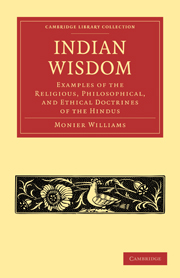Book contents
- Frontmatter
- PREFACE
- THE INDO-ROMANIC ALPHABET WITH THE EQUIVALENT SANSKṚIT LETTERS AND RULES FOR PRONUNCIATION
- Contents
- INTRODUCTION
- LECTURE I The Hymns of the Veda
- LECTURE II The Brāhmana Portion of the Veda
- LECTURE III The Systems of Philosophy
- LECTURE IV The Nyāya System of Philosophy
- LECTURE V The Sānkhya System of Philosophy
- LECTURE VI The Mimāṉsā System of Philosophy
- LECTURE VII Irregular Systems and Eclectic School
- LECTURE VIII Smṛiti. The Vedāngas
- LECTURE IX Smārta-sūtra. Gṛihya, ‘domestic rules’
- LECTURE X The Law-books. Mainu continued
- LECTURE XI Metrical Version of some of Manu's Moral and Religious Precepts
- LECTURE XII The Epic Poems
- LECTURE XIII The Mahā-bhārata
- LECTURE XIV The Epic Poems compared together and with Homer
- LECTURE XV The Artificial Poems
- INDEX
- ADDITIONS AND CORRECTIONS
- ORIENTAL WORKS
LECTURE XII - The Epic Poems
Published online by Cambridge University Press: 29 August 2010
- Frontmatter
- PREFACE
- THE INDO-ROMANIC ALPHABET WITH THE EQUIVALENT SANSKṚIT LETTERS AND RULES FOR PRONUNCIATION
- Contents
- INTRODUCTION
- LECTURE I The Hymns of the Veda
- LECTURE II The Brāhmana Portion of the Veda
- LECTURE III The Systems of Philosophy
- LECTURE IV The Nyāya System of Philosophy
- LECTURE V The Sānkhya System of Philosophy
- LECTURE VI The Mimāṉsā System of Philosophy
- LECTURE VII Irregular Systems and Eclectic School
- LECTURE VIII Smṛiti. The Vedāngas
- LECTURE IX Smārta-sūtra. Gṛihya, ‘domestic rules’
- LECTURE X The Law-books. Mainu continued
- LECTURE XI Metrical Version of some of Manu's Moral and Religious Precepts
- LECTURE XII The Epic Poems
- LECTURE XIII The Mahā-bhārata
- LECTURE XIV The Epic Poems compared together and with Homer
- LECTURE XV The Artificial Poems
- INDEX
- ADDITIONS AND CORRECTIONS
- ORIENTAL WORKS
Summary
IN India, literature, like the whole face of nature, is on a gigantic scale. Poetry, born amid the majestic scenery of the Himālayas, and fostered in a climate which inflamed the imaginative powers, developed itself with Oriental luxuriance, if not always with true sublimity. Although the Hindūs, like the Greeks, have only two great epic poems—the Rāmāyaṇa and Mahā-bhārata—yet to compare these vast compositions with the Iliad and the Odyssey, is to compare the Indus and the Ganges, rising in the snows of the world's most colossal ranges, swollen by numerous tributaries, spreading into vast shallows or branching into deep divergent channels, with the streams of Attica or the mountain-torrents of Thessaly. There is, in fact, an immensity of bulk about this, as about every other department of Sanskṛit literature, which to a European mind, accustomed to a more limited horizon, is absolutely bewildering.
Nevertheless, a sketch, however imperfect, of the two Indian Epics can scarcely fail to interest Occidental scholars; for all true poetry, whether European or Asiatic, must have features of resemblance; and no poems could have achieved celebrity in the East as these have done, had they not addressed themselves to feelings and affections common to human nature, and belonging alike to Englishmen and Hindūs.
I propose, therefore, in the next three Lectures, to give a brief general idea of the character and contents of the Rāmāyaṇa and Mahā-bhārata, comparing them in some important particulars with each other, and pointing out the most obvious features of similarity or difference, which must strike every classical scholar who contrasts them with the Iliad and the Odyssey.
- Type
- Chapter
- Information
- Indian WisdomExamples of the Religious, Philosophical, and Ethical Doctrines of the Hindus, pp. 309 - 370Publisher: Cambridge University PressPrint publication year: 2010First published in: 1875

